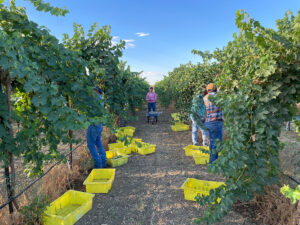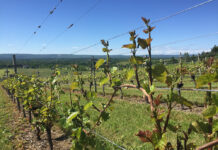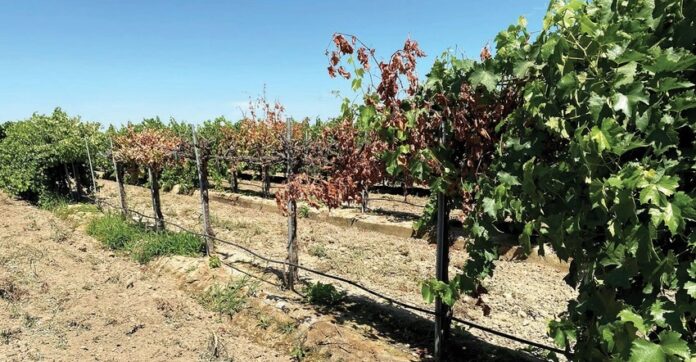Known for its high vigor and related strong yields, Freedom rootstock gained popularity and accounts for about 25% of recent wine grape vineyard plantings within the state.
Nevertheless, the rootstock has lost favor in some areas as it is sensitive to viruses and may succumb to sudden vine collapse (svc) when leafroll virus and vitiviruses are present.
In a quest to find replacements for Freedom, Karl Lund, a UCCE viticulture advisor in Madera, Mariposa and Merced counties, conducted replicated trials in two Central Valley vineyards with seven rootstocks.
RS3 and RS9 are interspecific hybrids from the USDA breeding program with broad resistance to many of the common nematodes, including virulent rootknot nematodes. The GRN series of hybrids (GRN1, GRN2, GRN3, GRN4 and GRN5) have broad resistance to many of the commonly found nematodes, including ring nematode, as well as to phylloxera. They were developed by the UC Davis grape breeding program.
These newer rootstocks have varying levels of vigor and not all may be suited to the Central Valley, Lund said.
“We have to figure out how they’re going to affect the rest of the quality beyond nematode resistance,” he told attendees of the 72nd Annual Lodi Grape Day.
Lund’s counterpart in Fresno County, George Zhuang, completed a trial evaluating seven rootstocks including two UC nematode-resistant ones under saline soil and water conditions in western Fresno County in 2022. Among the readings he took were pruning weights and yield.
Following that trial, Zhuang planted a new one in 2021 with seven rootstocks and two different scions including two of the new UC nematode-resistant rootstocks.
Virus Complex Complicates Rootstock Choices
The cause for concern is Freedom when it’s infected with both grape leafroll-associated virus 3 (GLRaV-3) and vitiviruses. Freedom is one of the most virus-sensitive rootstocks currently on the market.
Although the exact mechanisms aren’t fully understood, researchers hypothesize vines grafted onto virus-sensitive rootstocks that become co-infected with the two viruses as well as possibly other viruses are predisposed to root stress. Combinations of the viruses appear to be synergistic and can lead to vine decline.
Additional infections by fungal pathogens associated with grapevine trunk diseases, such as esca, dieback, canker and black foot, may cause rapid vine collapse.
“Until I saw it, I thought this wasn’t a big deal,” Lund said about sudden vine collapse. “Now that I’ve seen it, this is a big deal. We probably shouldn’t be using Freedom in the future if we can’t control leaf roll. The vines were perfectly healthy at the end of June and had raisined in July, a one-month period. By the end of August, the vines had died.”
If he were a grower, Lund said he’d be wary of planting Freedom when GLRaV-3 was nearby. That’s because the viruses can be spread by scale insects and vine mealybug, which can hitchhike on equipment and infested plant material.

Freedom gained popularity because it is vigorous and produces a large canopy that helps support the yields needed in the Central Valley, he said. Harmony, another high-vigor rootstock, lost popularity because it is susceptible to virulent root-knot nematode populations.
New Rootstocks Put to the Test
Both of Lund’s trials were in vineyards planted on single high-wire trellis systems designed for full mechanization. The Madera vineyard, planted in 2009, was grafted with the scion petite verdot. It had both RS rootstocks as well as the five GRN series. Freedom and 1103P were the industry standards that acted as controls.
The Merced vineyard, planted in fall 2016, had GRN2, GRN3, GRN4, RS3 and RS9 rootstocks as well as 1103P as the standard control. It was grafted with the scion malbec.
The two trials also differed in their layout, with the Madera one having a larger variety of rootstocks per replicate and the Merced site having a larger number of vines on each rootstock.
One of the main traits Lund focused on was canopy size. To determine that, he placed a solar panel beneath the canopy between noon and 2 p.m. to measure the amps produced. By comparing it to readings taken in full sun, he was able to determine crop shading and ultimately canopy size.

In the Madera trial in 2023, Freedom, GRN2, GRN3, GRN4 and GRN5 were in the larger canopy group while the remainders were in a smaller canopy group. Throughout the seasons, Freedom and GRN2 always had the largest canopies, with GRN1, RS9 and 1103P bringing up the rear.
Yields roughly followed canopy vigor, with Freedom topping the Madera trial with 19 tons per acre. GRN2 and GRN3 yielded about 16 tons per acre, followed by GRN1, GRN4 and GRN5 producing between 14 and 15 tons per acre. RS9 and 1103P were at the bottom with less than 12 tons/acre.
“Freedom still is the yield king, with GRN2 and GRN3 a step behind,” Lund said. “GRN1, GRN4 and 1103P were further behind.”
The results from the Merced trial differed slightly with 1103P performing more as expected as far as canopy size. GRN2 produced one of the largest canopies, followed close behind with GRN3. GRN4, RS3 and 1103P had more moderate canopies, while RS9 had the smallest canopy. Yields didn’t necessarily correlate to canopy size due to wide variability within the site.
Overall, GRN3 had the highest yield, followed by RS3, RS9, GRN4 and 1103P. Bringing up the rear was GRN2. Lund said the poor performance could be due to the rootstock taking longer than others to become established, a trait also seen by Zhuang and UCCE Viticulture Advisor Tian Tian in Kern County.

Fresno Trials
Zhuang’s original replicated trial involved the scion pinot gris and seven rootstocks including GRN2 and GRN3 planted on a single high-wire trellis system.
Although the trial focused on boron and salinity tolerance, he also took pruning weight samples as well as yields. Pruning weight typically reflects plant vigor. And both GRN2 and GRN3 had heavy pruning weights and strong yields.
“One of the interesting things about GRN2 and GRN3 is they were better not just from the pruning weight and yield but they also tended to have boron tolerance,” Zhuang said. Sampling found lower levels of boron in the petioles of vines grafted onto those two rootstocks.
Another trait he noted was the slow start for vines grafted onto GRN2 and GRN3.
“The first two years, you have to be very careful about training those vines because they’re very slow to begin,” Zhuang said. But once they become established, he found they yielded well.
The second replicated trial, planted in 2021, involved scions French colombard and barbera planted on seven rootstocks including RS3 and GRN3. He didn’t include many of the other UC nematode-resistant rootstocks because Lund’s trial showed they didn’t perform as well.
Zhuang and his crew harvested the first crop in 2023, and he said he liked to have at least three years of data before drawing conclusions about rootstock performance.
Looking Beyond Yield
Yields aren’t the only rootstock traits to consider, especially with repeated droughts in the San Joaquin Valley and the Sustainable Groundwater Management Act, Lund said. He also looked at how the rootstocks reacted to drought-like conditions throughout the growing season as well as regulated deficit irrigation over a specific period such as post-veraison.
Across three seasons of water stress in the Madera vineyard, Freedom and GRN2 had the lowest level of water stress. On the other end, RS3, RS9 and 1103P exhibited the highest levels of water stress.
The one issue Lund has with GRN3 is it also becomes highly water stressed and throws a “water stress tantrum.” But it returns to low to moderate water stress levels once irrigation is restored.
When the vineyard management team implemented post-veraison stress for grape quality, Freedom and GRN2 still showed the lowest stress levels. On the surface, 1103P also appeared to exhibit lower water stress, but the outer canopy layer burned, leaving the canopy damaged. After the canopy recovered, 1103P went back into the high-water stress category.








